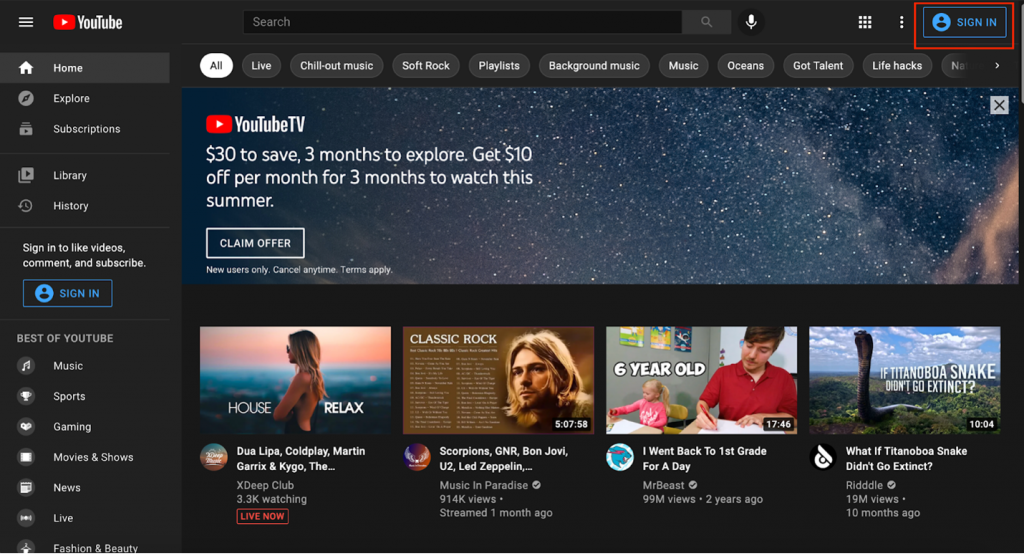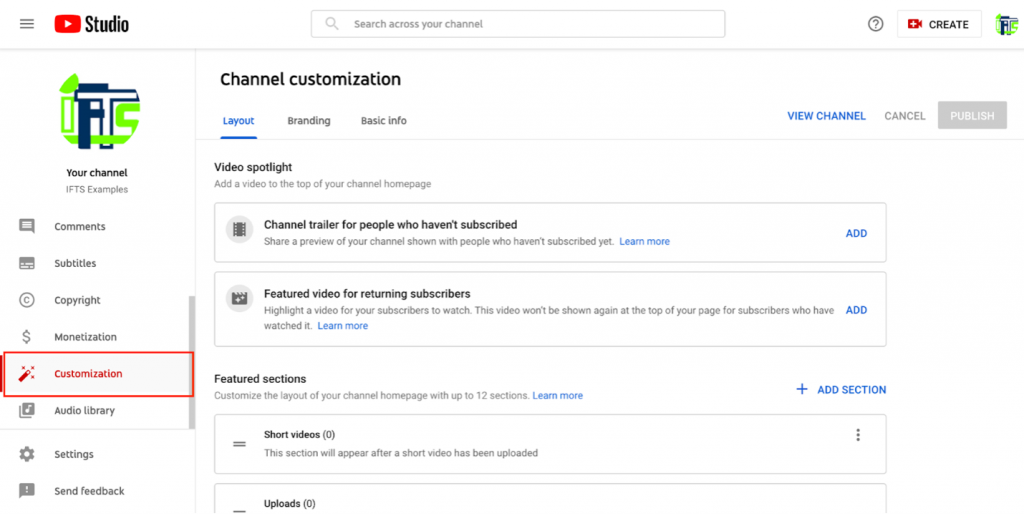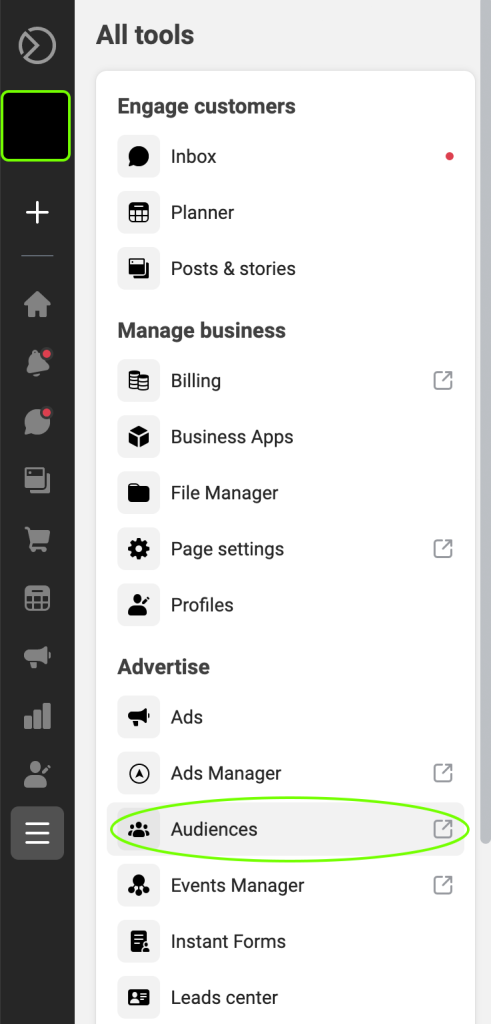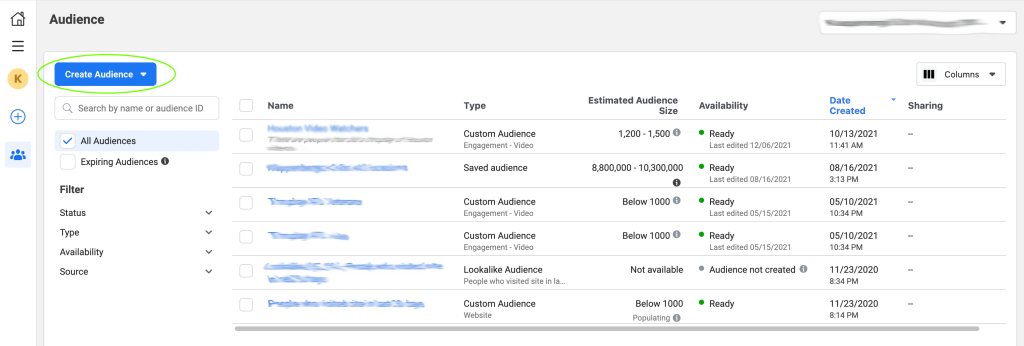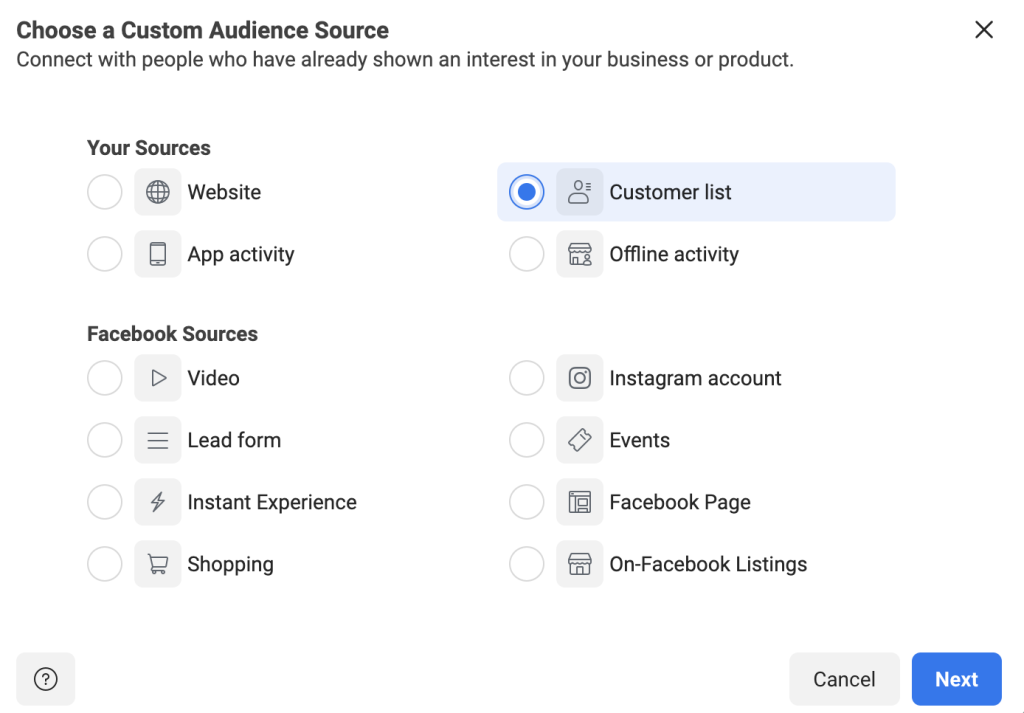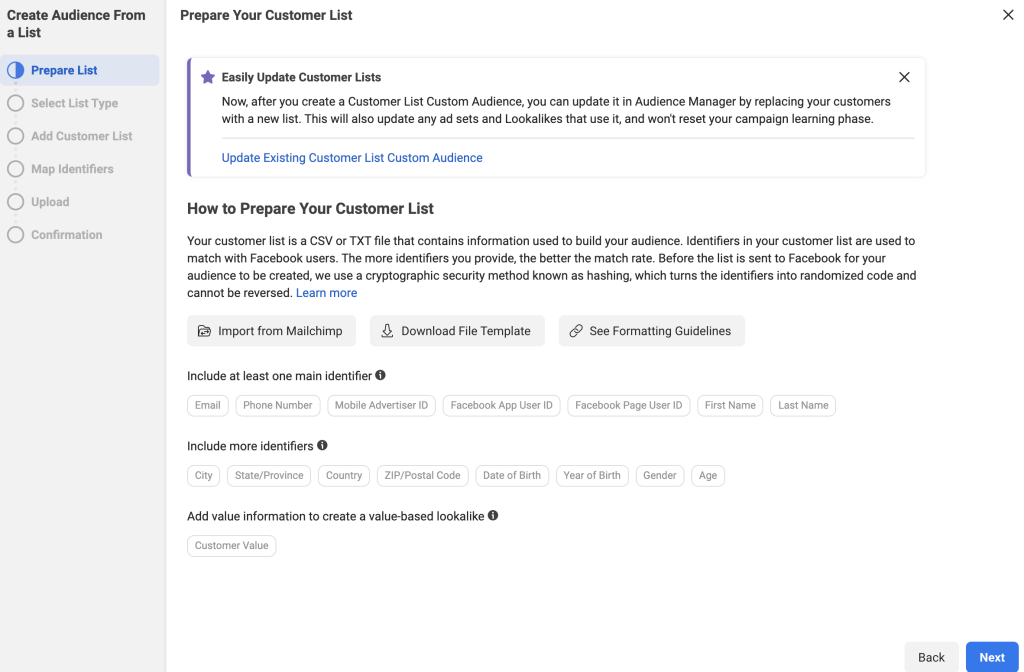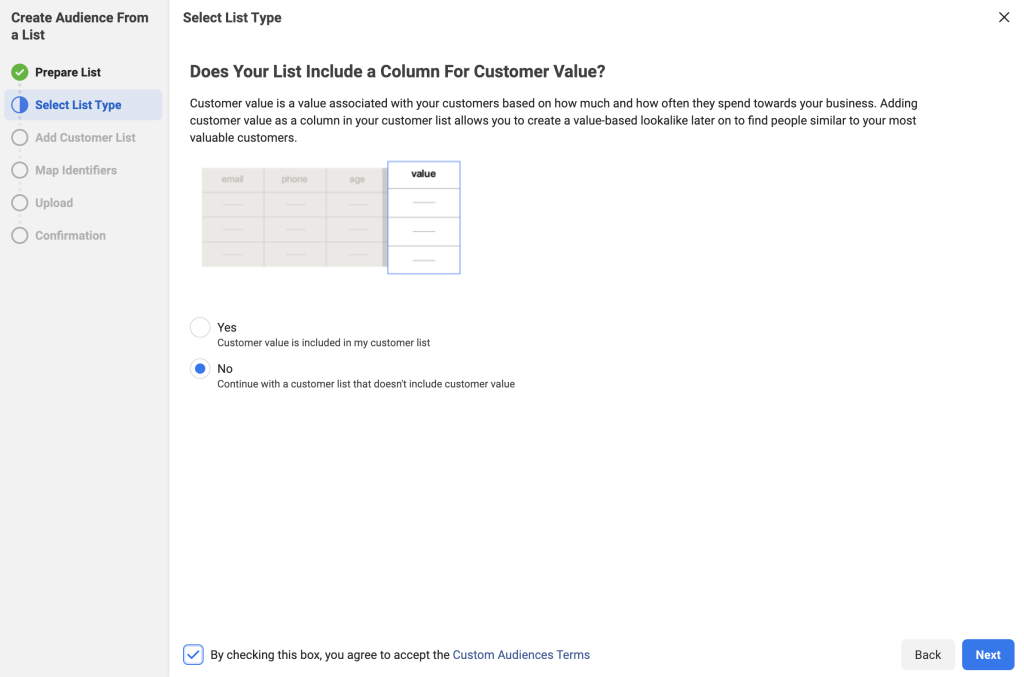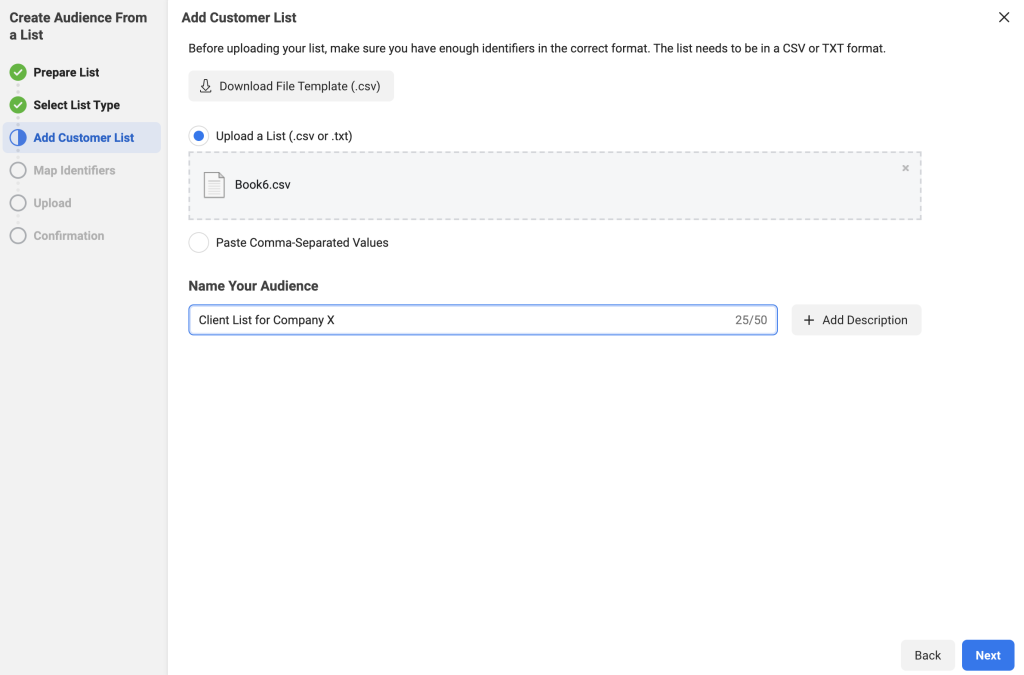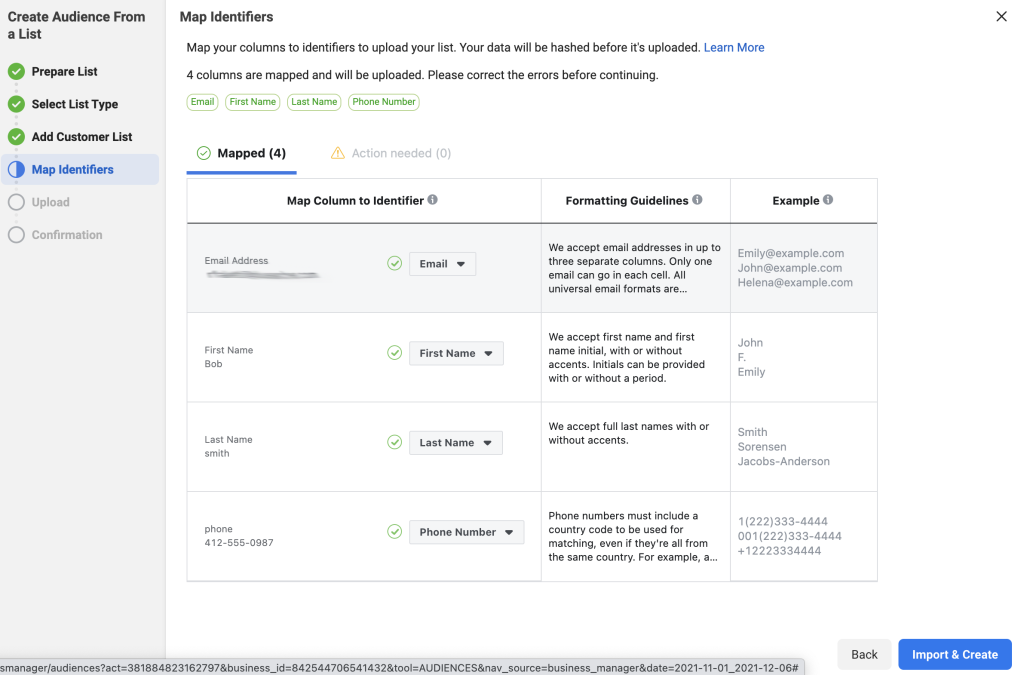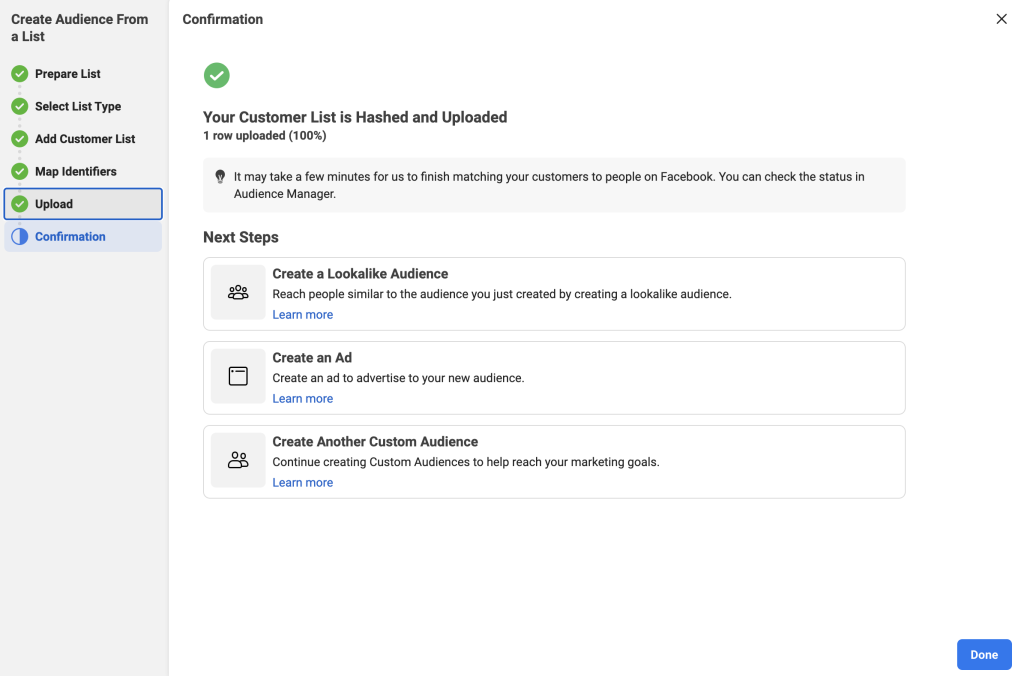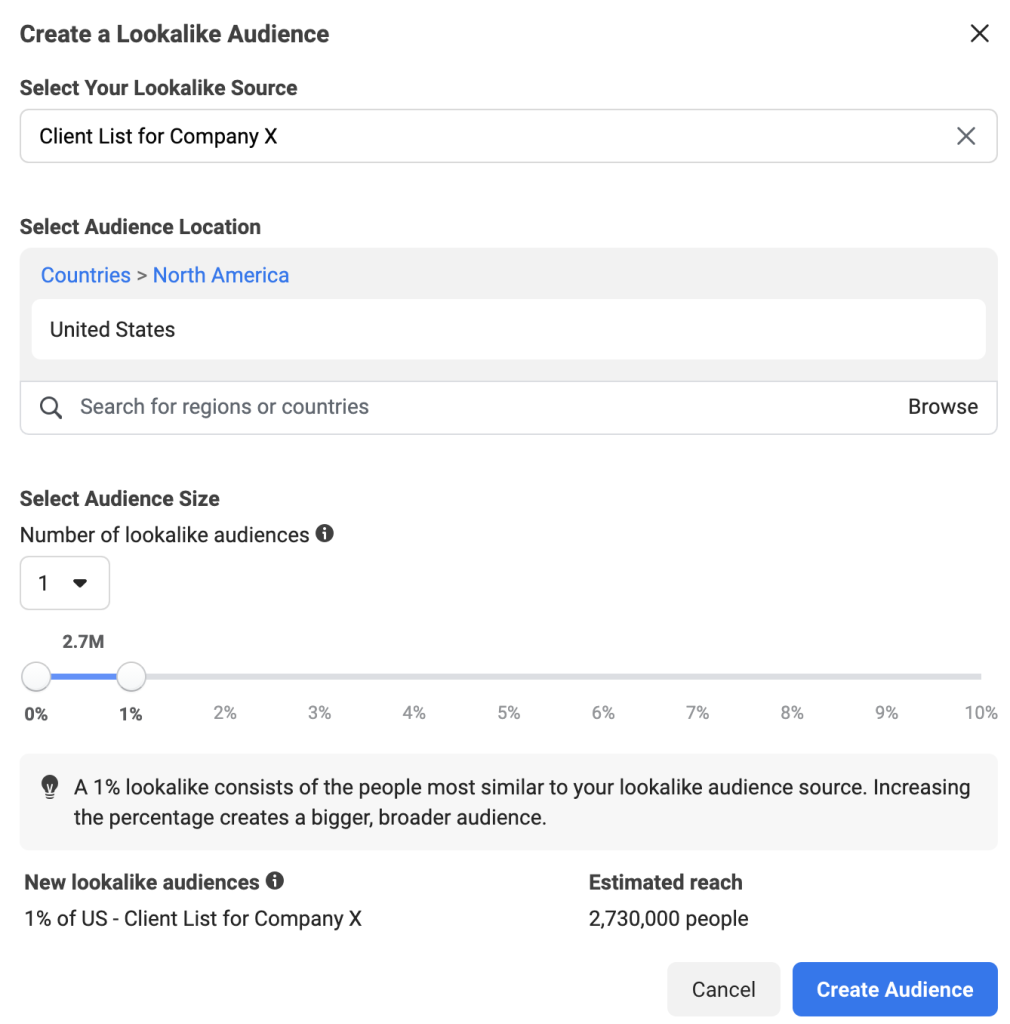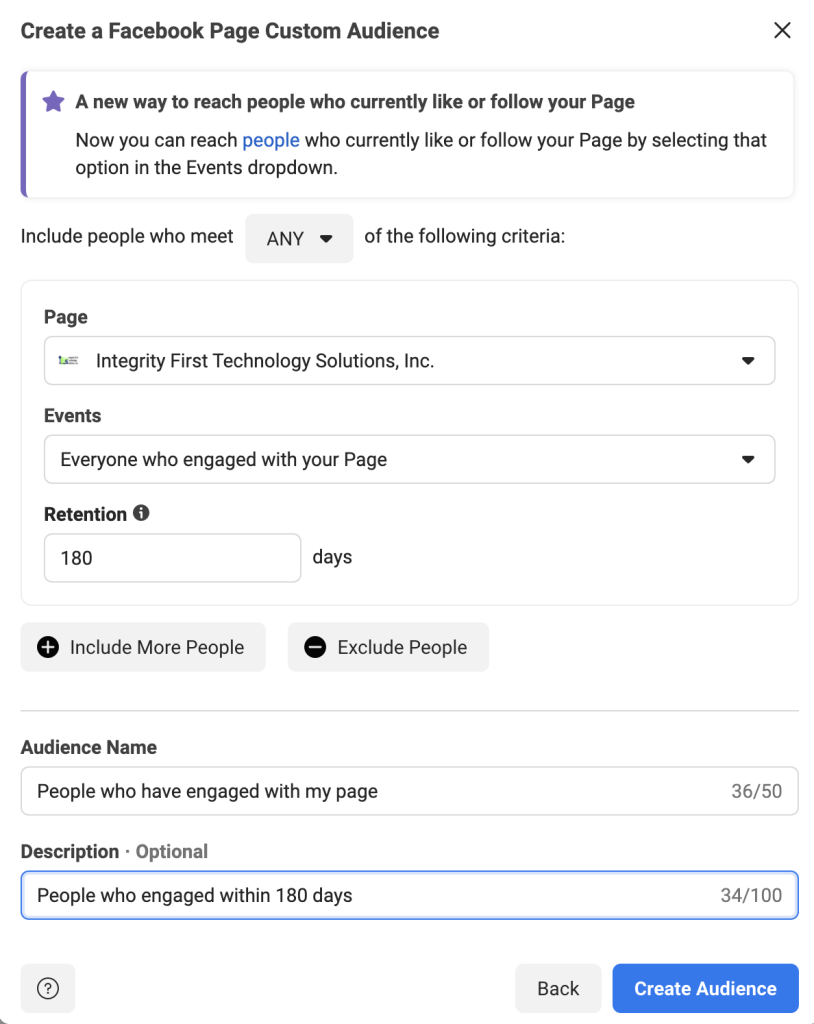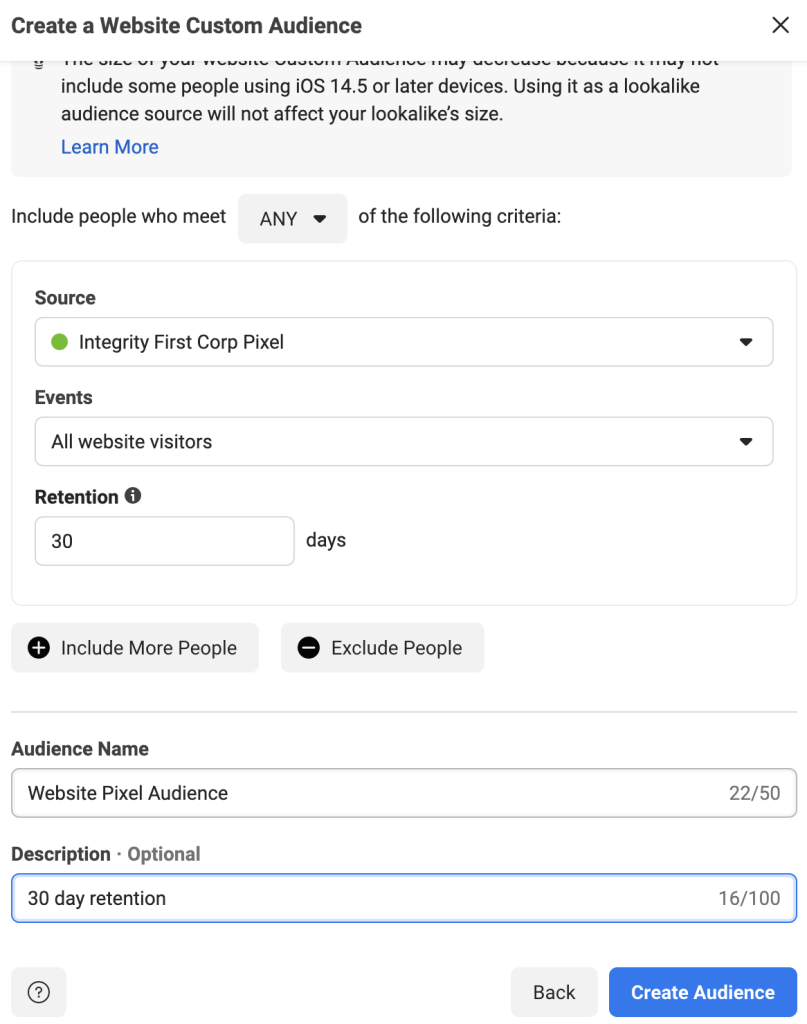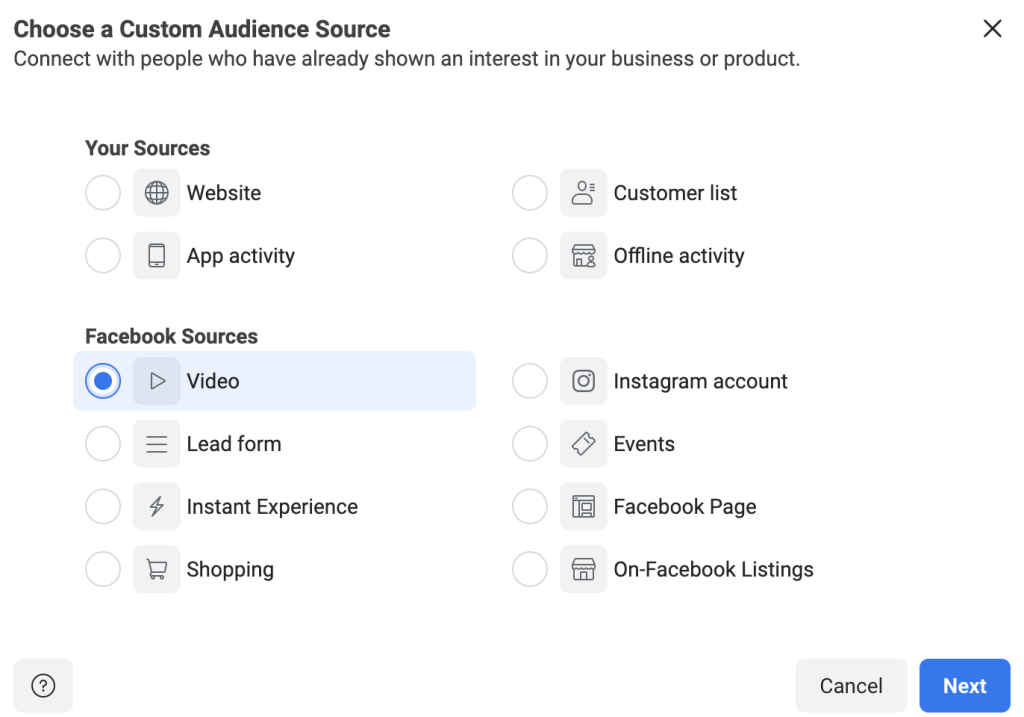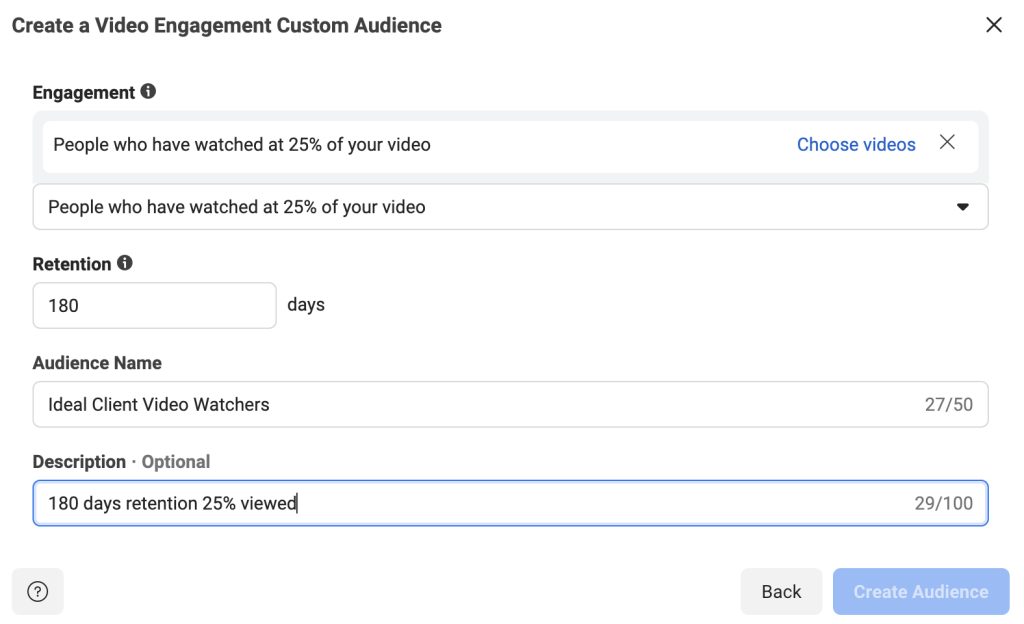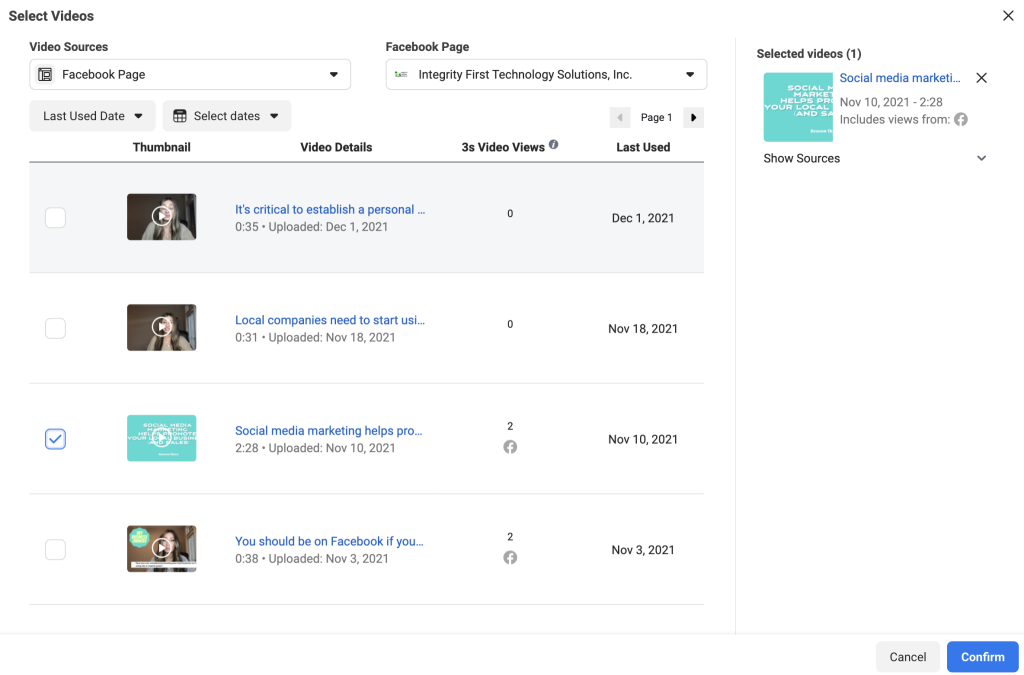Do you want to expand your painting business but don’t know where to begin?
It’s challenging to determine where to put your time and money or what measures to take. However, we’ve put together a step-by-step guide that will help you 10X your painting company.
Part 1 of 5: Implement A Follow Up System
Step 1 – Implement A Follow-Up System So Your Potential Clients See You Over and Over
Did you realize that just 3% of your market is ready to buy from you at any time?
This suggests that 97% of the individuals who see your advertisement will require a bit more time. Every day, your average consumer is exposed to around 10,000 marketing communications.
What are the possibilities that your marketing message will stand out among the 10,000 that your client is exposed to (particularly if they have never heard of you)?
In order to make an informed purchase choice, your potential clients will often need to see and hear from you many times. This is why you must CONTINUE TO FOLLOW-UP. In fact, according to a Google study from 2011, a customer requires 7 hours of engagement over 11 touch points in four places.
Let’s take a look at that in more detail. You (or your marketing) must interact with (or be seen by) your prospective client 11 times. Snail mail, videos, ads, phone calls, emails, or anything else that brings you in front of them can be used.
Then, these 11 exchanges must take place across four different online locations. This implies you can’t always call or send an email. You must increase the number of places where people may see you. You must be “everywhere” your customers are. As a result, adding to phone or email, Text, Facebook Ads, YouTube, the Google Display Network, LinkedIn, and other platforms is a good idea. Consider where your clients commonly are when accomplishing this task.
Finally, these touches must provide around 7 hours of interaction. To put it another way, you want a prospect to spend roughly 7 hours thinking about you. This is when having video comes in handy. Customer testimonials are excellent advertisements for a house painting company. It lets others “toot your horn” for you so you don’t have to.
A downloadable document with information about your organization, examples of your previous work, before and afters, and testimonials are other wonderful interaction pieces. You may share this on your website or through social media.
How To Implement A Great Customer Follow-Up System – Set Up A 3×3 Contact Matrix
First and foremost, automation is your friend. Don’t be afraid of technology because it appears to be complicated. It will be worthwhile in the long run.
So, what’s the first thing you’ll need to do?
Use a CRM (Customer Relationship Management) system like GoHighLevel, CorkCRM, or Keap to get started. In the long term, it will more than pay for itself in the time that you save and the clients that you gain.
You’ll need to create a 3×3 contact matrix in your CRM. As soon as a potential customer inquires about your services, you want to follow up with them by phone call, text, and email. If you don’t hear back from them within three days, try again. Do it again in 5 days if they don’t reply or engage. This means that you’ll have nine encounters with people on three distinct platforms.
“What if they become angry or tell us it’s too much?” is a typical concern expressed by painters.
They are not going to. Remember, they were the ones who contacted you first. It will be appreciated if you provide them with as much information as possible to help them make an informed selection when hiring a home painter. Providing additional information about working with you and your company should not be a deterrent.
“What should I say in these emails, messages, and phone calls?” is another regular question we hear.
- CALLS: The calls can just be follow-ups following the first contact for an estimate, as most painting companies are accustomed to.
- TEXTS: The texts should be brief messages requesting a response in order to keep people engaged. This is also a good time to offer a special deal that they can only receive if they respond. Keep these short, sweet, and to-the-point.
- EMAILS: Emails are where you can truly shine and promote your business. Send them more details about what it’s like working with your company. Do you have a video testimonial? This is the ideal time to share it with them. Do you provide anything truly unique in your area, such as a guarantee or a special technique? Share it here.
People buy with their emotions and justify their purchases with logic. To get people emotionally involved, use these 9 points of contact. Then provide them the facts to back up their decision.
How To Implement A Great Customer Follow-Up System – Play The Follow Game
Have you ever looked at a toaster on Amazon and then realized you’re seeing it everywhere? The same principles should be applied to your painting business.
The Facebook pixel and the Google cookie are two tools that can be used to accomplish this.
Install them on your website (and make sure their use is included in your terms and conditions), and they’ll start tracking your website visits. You may now show Facebook advertising to people who have visited certain pages on your website. In a similar way, you may utilize the Google cookie. This allows you to retarget all website visitors with ads for your house painting business!
Using Video Ads is another approach to interact with people several times based on their previous browsing activity. Create a series of three videos in which you respond to typical questions about hiring home painters. Use the questions that potential clients ask you all of the time. These videos don’t have to be formal or expensive to be effective.
This can be accomplished using a video that was filmed with a cell phone or tablet. Just make sure that you have decent lighting, so they can see your face!
Use these three videos to reach a large audience on Facebook. You’re going to use them to screen people out. Then, in a follow-up, market your services to those who have watched at least 25% of one of your videos.
Why just 25% of a video?
Because no one will watch a video on frequently asked questions about house painting unless they are looking to paint their home. This is a fantastic technique to narrow down your target audience and show your call to action to interested parties.
This strategy may be used on YouTube as well.
How To Implement A Great Customer Follow-Up System – Advertise on Multiple Platforms
You must promote on various platforms in order to be “everywhere.”
Google Ads is a fantastic tool that allows you to promote your business on Google, YouTube, Gmail, and the Google Display Network (GDN). The GDN enables your ads to appear on websites where Google has leased space. Google lets you choose the sort of website “lease” you wish to rent. As a house painting business, Home Improvement or Home Decorating sites can be a smart place to start.
Side note – you may want to avoid the “DIY” categories.
Facebook Ads are another wonderful way to target certain audiences with various sorts of advertising. Videos outperform static ads, so start filming! Don’t be afraid to let your potential clients put a face to the name of your business.
Depending on the type of work you do, LinkedIn advertising may be able to assist you in reaching out to certain professionals. This typically tends to help with commercial work contracts.
How To Implement A Great Customer Follow-Up System – Let’s Look At An Example
To really illustrate how powerful just this one step is, let’s look at an example painting business, ABC Painting.
Let’s say that ABC Painting gets 60 leads per month, their close rate is 15% and the average painting project in their area is $5,000. This means that they will get 9 clients and the company will gross $45,000 per month.
If you implement the follow up systems discussed above, you will increase your leads by about 60%.
To use the numbers above, this means that instead of 60 leads, ABC Painting will now have 96 leads per month. They will close on 15% of them, which is 14 clients and the company will now gross $70,000.
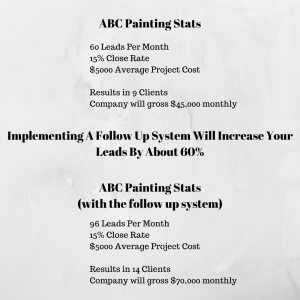
See, the CRM really will pay for itself…
Keep reading to learn how to double your leads!
Part 2 of 5: Double Your Number Of Leads Today
If you want to expand your painting business, you must commit to taking the steps to grow. By just doubling your leads (at the very least), you will have more work coming in than ever before.
This is when things become a little complicated and people get confused.
“How exactly do I double the leads for my painting business?” is a commonly asked question.
The honest answer is that you should try a variety of options and find what works best for you and your company. Lead tracking strategies will be required in order to determine what is working and what is not. This will tell you where exactly to spend your marketing budget.
Let’s go over a couple methods (or combinations of methods) for doubling your leads.
Marketing Tactics To Try To 2X Your House Painting Leads
Marketing Tactic 1 For Painting Companies – Facebook Ads
Facebook Ads, as indicated in Part 1, may be an efficient strategy to attract new clients.
Because video outperforms photos, make sure you record a number of short videos at your next job site. Most clients will be ecstatic to have their house transformation featured.
You’ll need to make two video sets. Videos that do the following should be included in Set 1:
- Provide an answer to a frequently asked question about home painting.
- Talk about getting a house ready to paint.
- Discuss why and when to paint certain areas.
- Discuss how the weather affects the painting process.
Video set 1 should consist of videos that people would watch solely if they were considering painting their interiors, exteriors, cabinets, or other surfaces.
Set 2 of the video should introduce your company and explain why they should hire you. The following should be included in these videos:
- Showing off the quality of your work
- Awesome before and after shots
- How tidy you keep the work area
- Anything else that makes your stand out
Set 2 videos should also have a call to action for them to contact you or make an appointment.
Schedule Video Set 1 to individuals in your region. The following options are typically recommended to get your Facebook targeting a bit more specific:
Age – 40+
Gender – Female (Women tend to make the household buying decisions)
Radius – Within 20 (or 30) miles of your business
The radius should really reflect how far you are willing to travel for house painting projects.
You’ll want to schedule Video Set 2 after Video Set 1 has been running for a few days. Only those who have seen at least 25% of one of the videos from Set 1 should be shown these videos. This way, you know you’re reaching out to people who are at least considering painting their home.
If you have the Facebook Pixel set up correctly, you can also show Video Set 2 to users who have visited your website.
Marketing Tactic 2 For Painting Companies – Google Ads
Google Ads may be a powerful tool for generating online leads. In fact, we’ve seen leads for companies we’ve worked with come in for less than $50 per lead. When it comes to the settings, though, Google Ads can be a little complex. This complexity typically leads to mistakes and can cost a painting business money if they are not careful.
Let’s look at some of the most frequent Google Ad “gotchas.”
First, you must choose the type of advertisement you wish to run:
- Search Ads are the text ads that you see at the top of the results page, before the map and the organic results
- Display Ads are the image ads that you see across the web when browsing
Although both types of ads have advantages, you should never create a Search Ad that also targets the Display Network or vice versa.
Second, double-check that you’re utilizing keywords in the way you intended.
Google has multiple types of keywords:
- Broad match
- Phrase match
- Exact match
According to Google, a broad match keyword is one that “may show on searches that are related to your keyword, which can include searches that don’t contain the keyword terms”
One of your keywords, for example, may be House Painters In My Area. However, those hunting for famous painters or automobile painters may see your ad.
Rule #1 of not overpaying for Google Ads – DO NOT USE BROAD MATCH KEYWORDS.
Google defines a phrase match keyword as one where “ads may show on searches that include the meaning of your keyword”. To denote a phrase match keyword, you’ll need to put it in quotes.
To use the example above, you would define one of your keywords as “House Painters In My Area”. Now, if someone entered in that term, your ad would appear. It may also appear if someone types in “Painters Near Me” or “House Painting Near Me.”
These are acceptable keywords (as long as you have a good negative keyword list, which we will discuss in a few moments).
Exact match keywords are the last type of keyword from Google. You put the keyword phrase in square brackets to indicate this. Google defines these as “Ads will show on searches that have the same meaning or same intent as the keyword.”
This type of keyword gives you the most control over when your ad appears, but it also restricts the number of people who see it. In the previous example, you would type [House Painters In My Area] as one of your keywords. Then, when someone types in this phrase or anything extremely close, such as the same words in a different sequence, your ad will appear. One example of this would be someone typing “House Painters My Area” into the search bar.
You’ll also want to make a list of negative keywords after you’ve entered your keywords. This is a list of terms and phrases that you input into Google Ads that informs them not to show my ad if this word appears in a search phrase. It allows you to filter out buyers who aren’t qualified.
Good negative keywords to use for your painting company:
- Any painting or store brand, like “Home Depot” or “Behr”
- “How To” or “How Much” (People searching these phrases are typically in the education phase of their searching and aren’t looking to purchase yet)
- Automobile, car, auto etc.
- Boat
- Bicycle
- Paint and Sip
- Face Paint
- Etc.
Put any terms or phrases that come to mind that are linked with painting but aren’t related to home painting on the list.
Finally, double-check that your keywords correspond to what you state in your advertisements, and that the landing pages you lead visitors to correspond to your ads. This is known as “Ad Congruity.”
For example, if you utilize the term “house painter” in your keywords and ads, make sure the page they are directed to emphasizes that you are a “house painter.” In fact, “house painter” should occur in your H1 header and your page title.
DO NOT SEND ANY OF YOUR ADS TO YOUR HOME PAGE! This is a significant, costly error that we see a lot of painting companies make. When people get sent to the home page, they don’t know what action you want them to take. A confused mind never buys, so be explicit in what you want all of your prospects to do.
Some Other Marketing Tactics For Painting Businesses
We wanted to review a few tactics in depth in this article. However, there are tons of other tactics to try, like:
- Door hangers
- YouTube ads
- Radio ads
- Appear on Podcasts
- Networking
- Find non-competing partners
- SEO
- TV
- Get featured on the local news
- And more!
Always Important to Remember – Measure Your Results
You must measure your results to determine which approach or tactics performed best. Call tracking is one technique used to accomplish this. For each tactic type, use a different phone number to determine which one generates the most leads. One vendor that provides this service and makes it simple to set up is CallRail. You get 10 phone numbers included with the basic account and the cost is less than $50/month.
You might want to attempt one tactic every month, though seasonality may have an impact on the results…or you can try them all at once!
To separate them out, each ad might be sent to a different landing page. Then you’d be able to tell which ad was the most effective according to your website’s analytics.
You just want to make sure that everything is measured, regardless of how you go about it. Once you know your metrics, you don’t have to limit yourself to just one! It’s best to eliminate the duds though.
Let’s Return To Our Example Company With Double The Leads For Our Painting Business
Again, let’s see how powerful doubling the number of leads that we bring in actually is.
Remember, ABC Painting started with $45,000 monthly gross revenue. Then, we implemented a follow-up system, which will increase the leads by about 60%. This took the gross monthly revenue to $70,000.
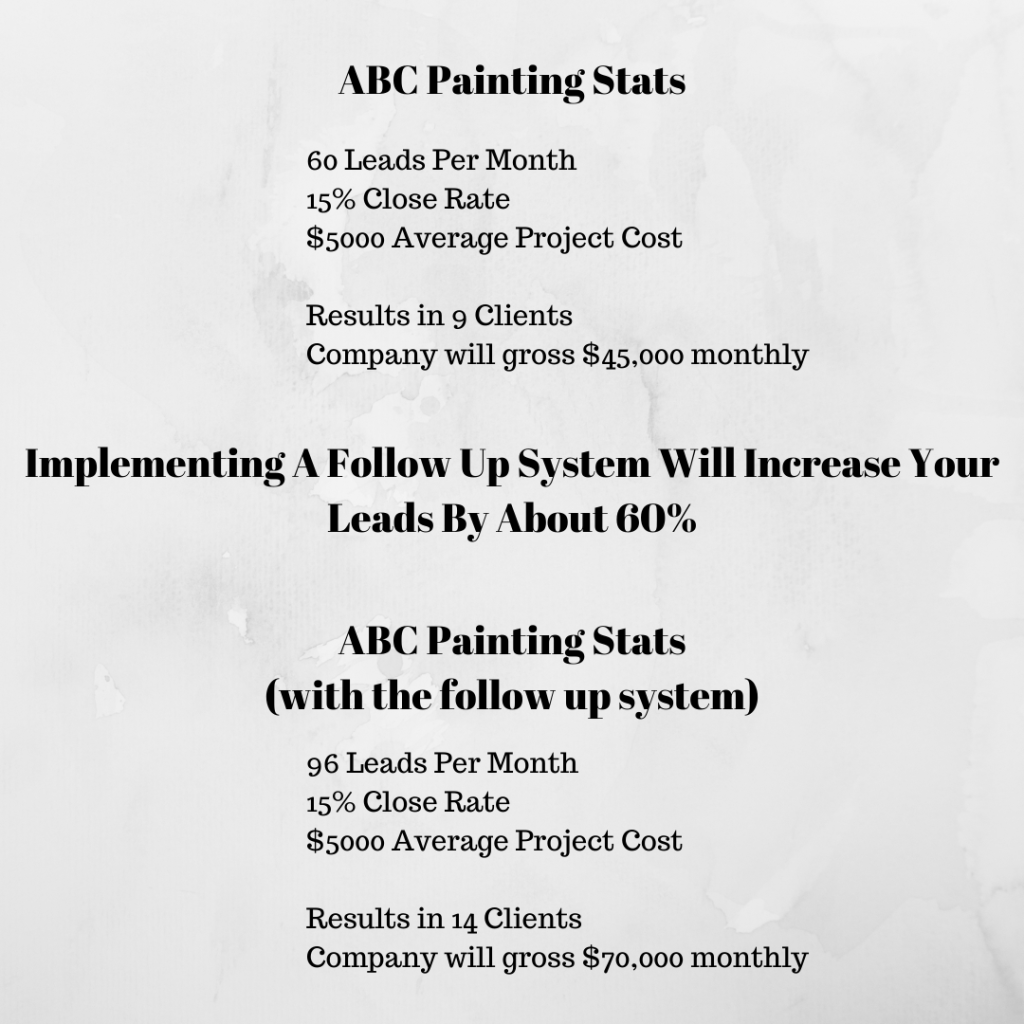
Now, through the tactics discussed in this article, we have doubled our leads from 96 to 160 192 per month.
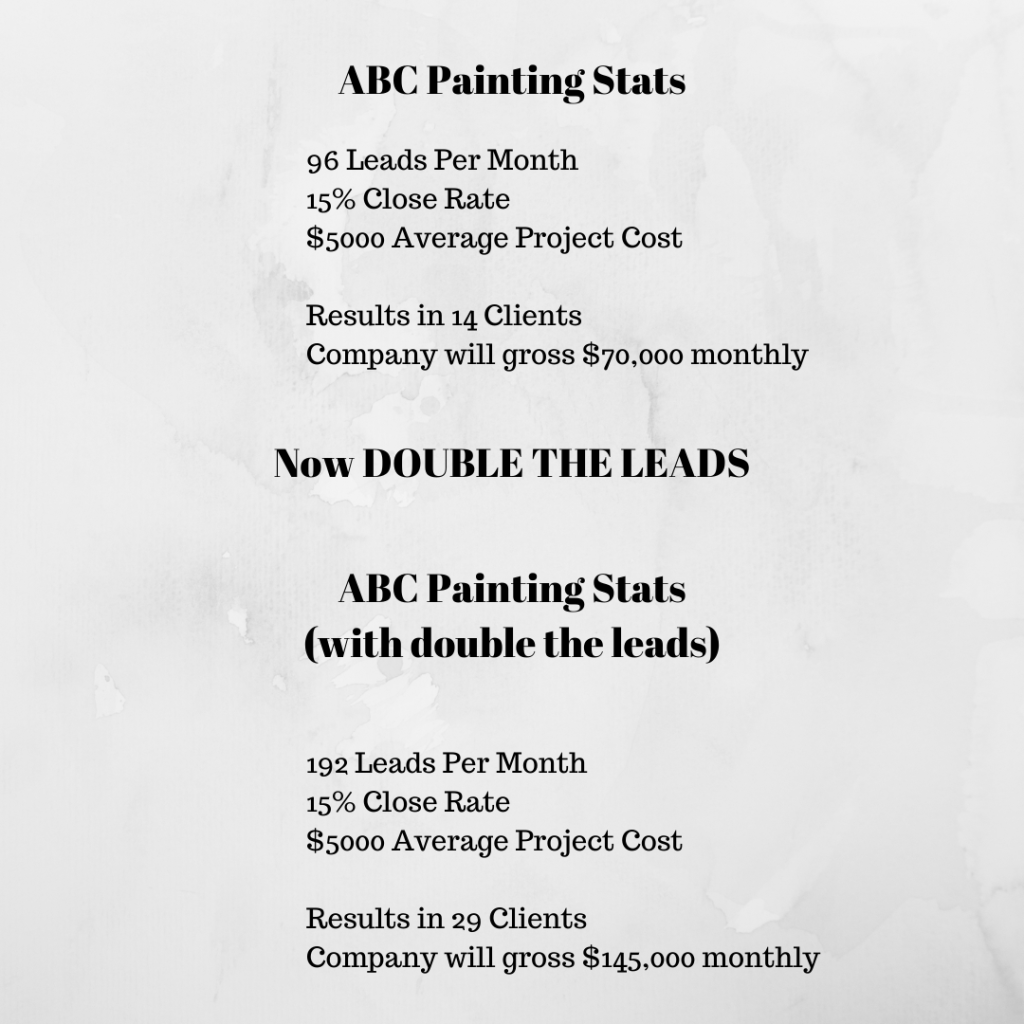
If that 15% close rate remains, this will result in 29 new clients and a monthly gross income of $145,000! We have already more than tripled the revenue using just 2 steps of this proven system!
Part 3 of 5: Work On Increasing The Closing Rate For Your Painting Business
Have you ever heard someone say – “People love to buy, but they hate to be sold to?”
I beg to differ. That statement is simply false. People like both buying AND being sold to. However, it has to be presented to them correctly with a certain mindset.
The important thing is that they need to have a quality sales experience. They’ll be delighted to be sold to!
What Exactly Constitutes A Great Sales Experience
As an example, think about buying a car.
When you go to buy a new BMW or Mercedes Benz, the salesmen in their luxurious offices offer you endless Starbucks and snacks. You get to relax in a beautiful lounge while the cars you wish to test drive are being prepared. Typically, you’ll be able to go out for a long test drive to check out all of the car’s features. Then, for the following months after you buy the car, you get fun small additions in the mail. They may even invite you to special track events where you will get the opportunity to drive souped-up cars.
Let’s compare this to purchasing a new Honda. You begin by entering a bare-bones sales floor and taking a number. When it’s your time, you’ll receive a 10-minute test drive during which the salesperson will go through the features briefly. You’re taken into a regular cubicle and the contract is placed in front of you when you return to the dealership. This isn’t meant to knock Honda, it’s just how they operate.
Although both automobiles will get you from point A to point B, which sales experience would you prefer? Most people, I believe, would agree that the BMW/Mercedes experience is preferable.
Selling Is A Process
The easiest way to get a client is for them to know, like and trust you. You can begin this process even before someone requests a quote from you or calls you on the phone.
As indicated in step one of this series, create a set of videos that answer frequent questions that you receive from clients all the time. You may also create videos that answer the most common objections you get from individuals who don’t hire you.
Then, promote these videos to your target audience on Facebook. Before they even contact you for a quote, they’ll get to know, like, and trust you.
Why?
Because you have provided value to them and demonstrated your expertise in the painting field without coming off as pushy. These videos serve as the initial stage of your sales pitch (and they don’t require much of your time). You want people to see you again and again. As a result, you establish yourself in their mind as the go-to painting company in the area.
BONUS TIP: Testimonial videos are a terrific method to build trust with potential clients while also showcasing your work without having to brag!
You’ve already gotten the hard part out of the way when someone calls you for a quote after seeing your videos. They know, like, and trust you because of your videos… and Individuals like to buy from people they like. It becomes a lot easier for you to seal the deal.
“Selling” Is A Dirty Word
“Sales” or “Selling” has recently earned a bad rap. You may immediately think of shady used car salesmen or worse. It just carries a negative connotation.
However, keep in mind that when you sell someone a quality house painting project, you are definitely helping them.
Perhaps you’re assisting them with painting their kitchen cabinets in order to increase their asking price when they sell their home. Perhaps you’re painting their house exterior and assisting them with weatherproofing for the winter. Perhaps you’re assisting a family in having a wonderful holiday in their newly painted living room.
Whatever the situation may be, you are assisting others in achieving positive goals. They are in a better position than they were previously! Remember this the next time you’re trying to close a deal. You should be in a completely different mindset than “straight sales”, which will help your close rate.
Increase Your Closing Percentage
Create a positive sales experience for customers that begins even before they contact your company. Your closing rate should more than double if you follow the advice above.
Let’s Return To Our Example Company With Double The Close Rate For Our Painting Business
Remember, ABC Painting started with $45,000 monthly gross revenue. Then, we implemented a follow-up system, which will increase the leads by about 60%. This took the gross monthly revenue to $70,000 with a close rate of 15%.
Next, we doubled our leads from 96 to 192 per month using the tactics in Step 2 of this article This resulted in 29 new clients and a monthly gross income of $145,000.
Now, if we can double the close rate from 15% to 30%, we will have 58 clients per month with a monthly gross income of $290,000! This is more than 6X the starting monthly revenue and we have 2 more steps to go!
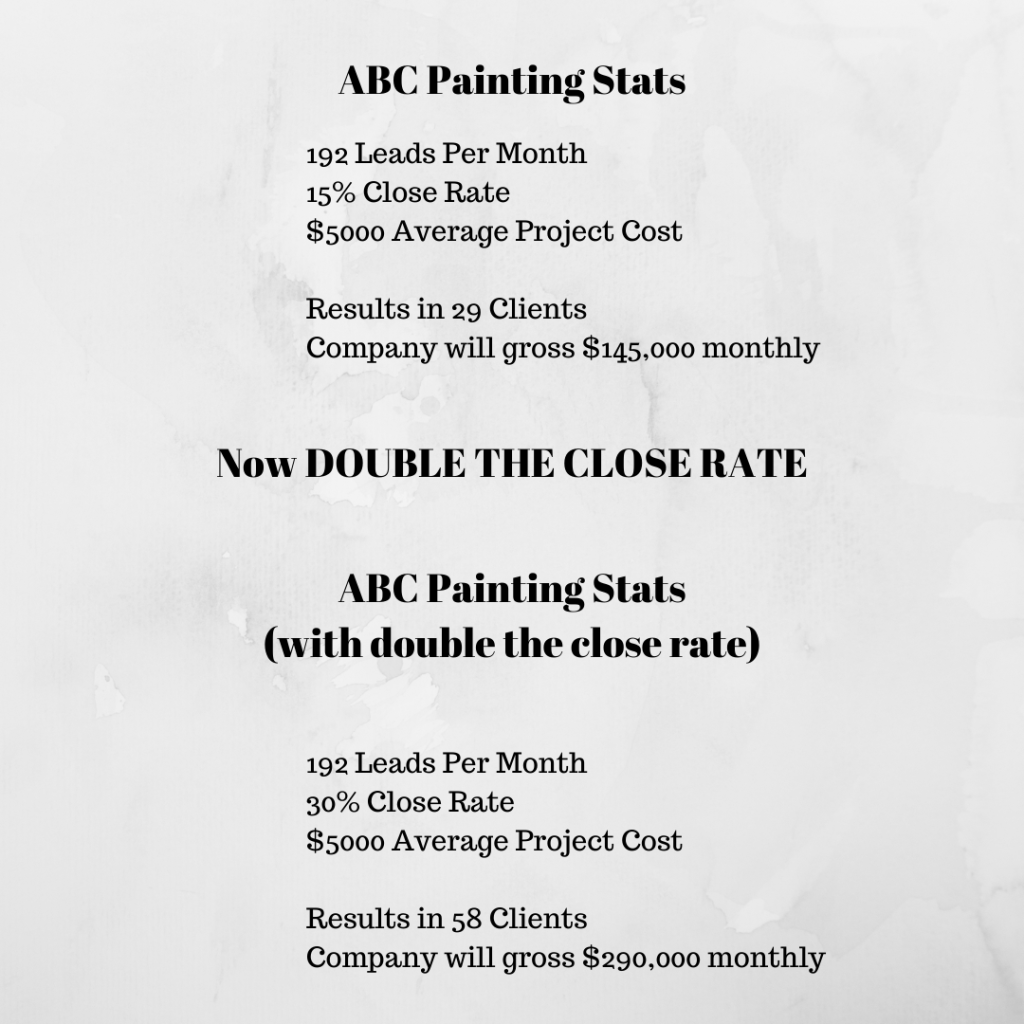
Continue reading to learn about adding a special upsell that will score you some high-ticket clients right away!
Part 4 of 5: Create a Premium Service Offering To Upsell Your Top Clients
Have you ever heard of the 80/20 rule or the Pareto principle?
It states that “80 Percent of Your Results Come from 20 Percent of Your Efforts, and 20 Percent of Your Results Come from The Other 80 Percent.”
This rule also applies to your customers. In most cases, 20% of your clients account for 80% of your income. Let’s apply the 80/20 rule to the top 20% of your clientele. 4 % of your clients account for 64% of your income.
So, what does this mean?
There will always be a tiny group of individuals at the top who are willing to pay a premium price.
Are you giving them that opportunity?
There will always be at least 5-10% of your clients that are willing to pay a higher price for a premium level of service.
A premium service will be superior to the services you now provide in terms of quality, speed, and ease…
It will also cost 2-3 times as much.
To create your premium service offer, you need to ask yourself 3 questions:
- What can you do to offer a better painting service than other companies?
- What can you do to be faster than other companies?
- How can you make your process easier than other companies?
Let’s look at a few examples for each question…
What can you do to offer a better painting service than other companies?
Take the time it generally takes you to finish a work and reduce it by 30% or more if possible to provide a speedier service. Offer kitchen cabinets painted and re-installed in a week (obviously kitchen size matters, so there can be a disclaimer). Offer rooms completed in a single day which are of high quality.
When you provide a faster service, it definitely sets you apart from the competition. People are always willing to pay a premium for speed as it lessens the inconvenience to them.
How can you make the painting process easier than other companies?
You have a variety of premium alternatives to offer, starting with the sales process. You may FaceTime someone as soon as they contact you and give them an estimate right away. As the first quote, this also puts you ahead of your competitors and allows them to put a face to your name.
You could offer a free hotel stay or a mini vacation (of course included in the price) while you work on their home. They don’t have to deal with the mess or upheaval…and you don’t have to deal with them as a bonus. This is something that a lot of companies do. Travel companies can provide you with excellent group prices.
If they have pets, you may pay pet sitters to take care of them while you are working in their home. There will be no accidents, and the pets will not be exposed to an unfamiliar situation.
Consider the problems that you are creating by painting their house and give remedies to develop your premium service.
How To Present The Premium Painting Offerings
Include premium services in your proposal. People enjoy having options, but not too many. People are more likely to make a purchase when given fewer options, according to research conducted in 2000. When it comes to premium services, just provide 2-3 selections at most.
This also makes individuals who choose your standard pricing feel like they got a great “deal” on your service.
Let’s Return To Our Example Company With A Premium Offering For Our Painting Business
Remember, ABC Painting started with $45,000 monthly gross revenue. Then, we implemented a follow-up system, which will increase the leads by about 60%. This took the gross monthly revenue to $70,000 with a close rate of 15%.
Next, we doubled our leads from 96 to 192 per month using the tactics in Step 2 of this series. This resulted in 29 new clients and a monthly gross income of $145,000.
Then, we doubled the close rate from 15% to 30%, which gave us 58 clients per month with a monthly gross income of $290,000.
Now, if we add a premium offering at $14,000 that 10% of our clients choose – we’ll have 192 leads per month with a 30% close rate. That gives us 58 clients. 90% of them, 52 clients, choose the regular offering at $5,000 and 10% of them, 6 clients, choose the premium offering at $14,000. This gives us a total revenue for the month of $344,000.
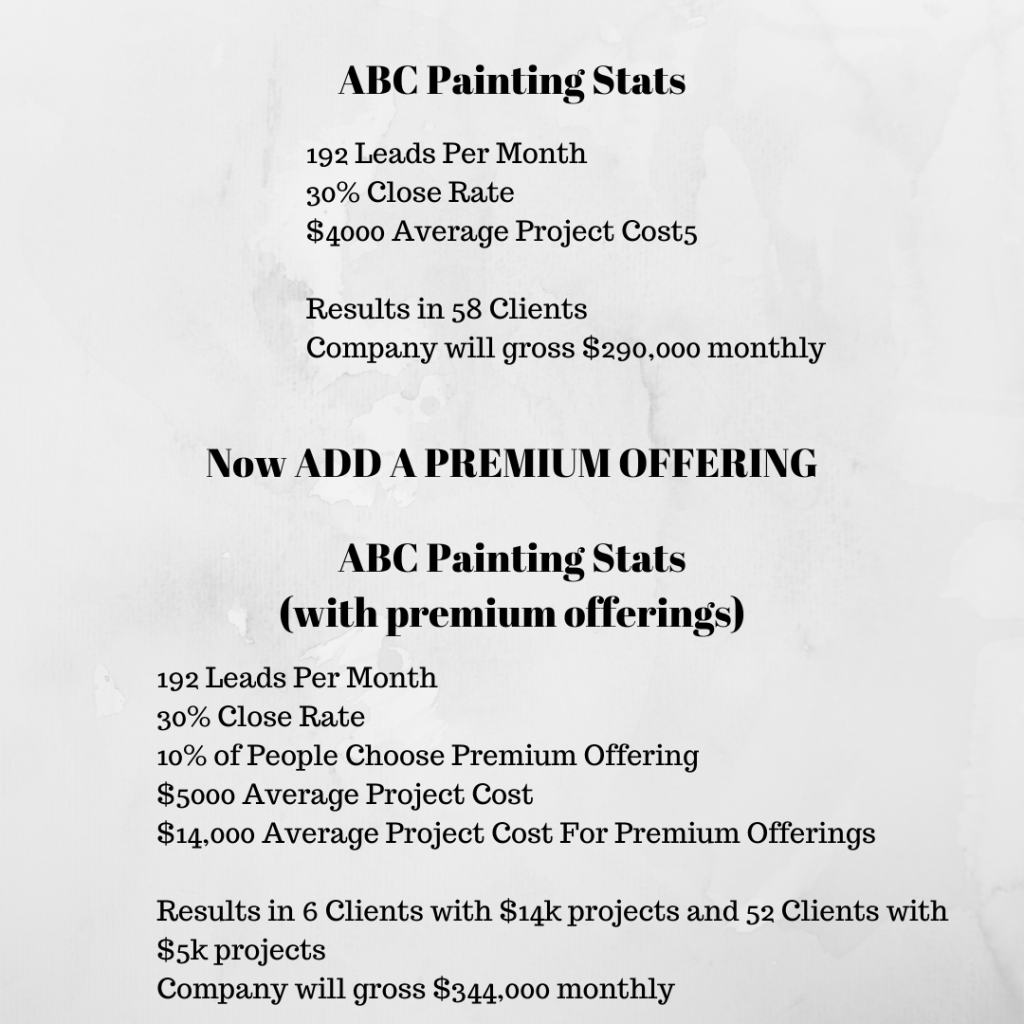
This is an increase of 7.6X
Read on to step 5 where we will talk about being the irresistible option, which allows you to charge what you want!
Part 5 of 5: Increase Your Pricing By Being THE GUY (or Girl)
Are you hesitant to increase your pricing for painting jobs?
The majority of painters are…
But you shouldn’t be, because competing solely on price is inherently bad. You only have 2 options: be the highest or the lowest. It won’t matter if you’re the second or third cheapest in town.
When you’re the cheapest, you’re also implying a low-quality component. Typically, the cheapest services are never the best. You don’t want your painting company to be associated with that stigma!
People will pay your prices, no matter what they are, if you are the most in-demand painter in town.
So, how can you become the town’s most sought-after painter?
You become the most well-known, well-liked, and well-trusted person. You can accomplish this using the videos, content, and Facebook ads we talked about in Step 1.
People in your neighborhood already know, like, and trust you because you provide information and value through your videos and articles. They are aware that you are an expert in your field and have seen proof of this.
As a result, when it’s time to hire a painter, they’ll think of you first. In fact, there’s a high possibility they won’t shop around at all. They will need to hire you because you’re the one they can trust with their home.
When this occurs, they will gladly pay whatever you ask… and because you are offering value and outstanding service, you can surely charge at least 50% more than you are charging today. You’ll receive the same number of clients and make more money.
Let’s Return To Our Example Company With A Premium Offering For Our Painting Business
Remember, ABC Painting started with $45,000 monthly gross revenue. Then, we implemented a follow-up system, which will increase the leads by about 60%. This took the gross monthly revenue to $70,000 with a close rate of 15%.
Next, we doubled our leads from 96 to 192 per month using the tactics in Step 2 of this series. This resulted in 29 new clients and a monthly gross income of $145,000.
Then, we doubled the close rate from 15% to 30%, which gave us 58 clients per month with a monthly gross income of $290,000.
In step 4, we added a premium offering at $14,000 that 10% of our clients chose, resulting in 90% of our new monthly clients (52) with the regular offering at $5,000 and 6 of them at $14,000. This gives us a total revenue for the month of $344,000.
Finally, in this step, we are going to increase the regular pricing by 50%. The 90% of our monthly clients (52) will now be at $7,500 and 10% of our monthly clients (6) will be at $14,000. This gives us an end result of $474,000 for the monthly gross income.
We have just 10X’d your monthly revenue in 5 easy steps!
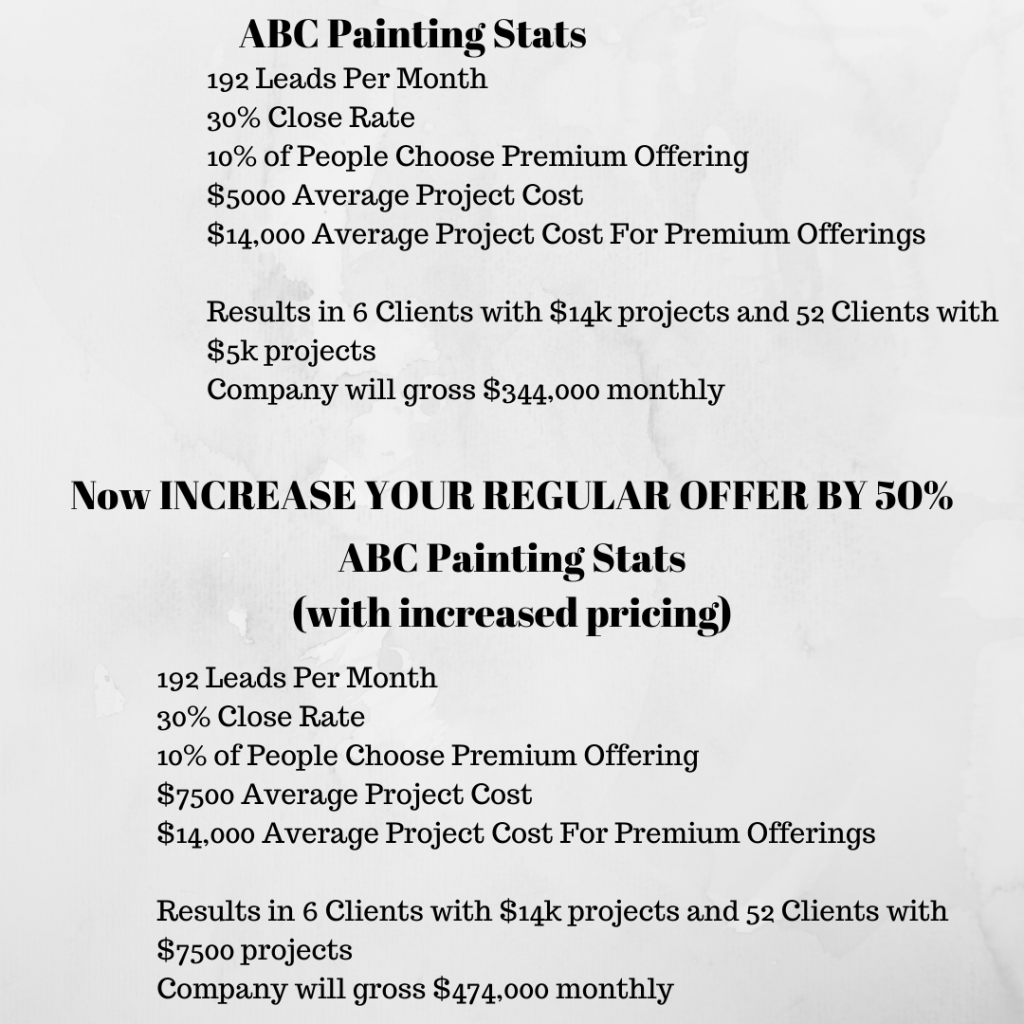
BONUS Tip: Increasing Your Recurring Revenue For Your Painting Business
Would you like to start each year knowing that you have at least $500,000 on the books?
You should be able to depend on at least 10% of your previous year’s clients to have a job for you in the current year or suggest you to someone who has a comparable job.
You want to stay “top of mind” for them in order to ensure that they remember you. There are a few options to stay in front of your current customers.
First and foremost, send out a monthly email newsletter. It doesn’t have to be fancy, and it shouldn’t be only focused on your business. Send out some monthly useful advice that would apply to your ideal customer, much like your videos and social content.
For example, if you were a painter in Virginia, September or October would be ideal for sending out an email with recommendations on weatherproofing your deck.
IFTS offers a service that does this automatically for painters for under $300 per month, so it pays for itself if you get just one repeat client.
Turning current clients into a Facebook audience is another way to stay in front of them. You just enter your customer list into the Facebook audience wizard. Then you can be sure to put helpful videos and articles in front of them on a regular basis via Facebook.
Note: You can use this audience to create a lookalike audience to send videos and fresh content to via Facebook Ads.
A final way to get in front of current customers to send them something via snail mail. Most businesses will send Christmas cards or something similar, but this will not set you apart from the competition. We recommend picking a holiday that most other businesses ignore, such as St. Patrick’s Day. Send them a “We’re Lucky To Have You As A Customer” card and see how many people come back to you!
By staying “top of mind”, you should see at least a 10% repeat from the year before.
If you followed the 5 step process that we discussed, you’d have a monthly revenue of at least $474,000…which is over $5 MILLION DOLLARS annually. So, if you have at least 10% of the people from last year hire you this year, you will start off knowing you have over $500,000 already on the books.
Ready To Get Started, But Want Some Help?
IFTS, Inc. can help your painting business implement these systems and more! Click the link below to schedule a meeting to get started or call us at 412.715.6266!
Get the Top 3 Social Media Post Templates for Painting Companies to Grow Your Following and Get New Clients
Engage with prospects and save time with your FREE Canva template kit. This kit features the top 3 social media posts for painting companies and directions on how to brand them for your own business in 5 minutes or less.

Enter your email below and get the templates sent directly to your inbox along with an instructional video on how to make personalized edits.



